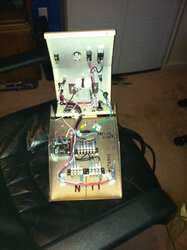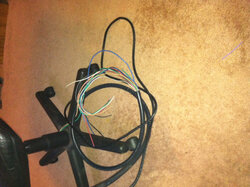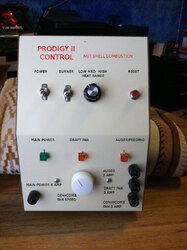Wooo hoooo

Thanks.
If you go back to the early 90's there were still several pellet stove manufactures using timers that were identical to what I have in "My Box"

if in fact, the same identical ones.
I chose the 10 amp version to give the system a lot more margin in case of a short in a motor.
The auger, draft fan, room air fan all have their own fuse with the auger being 2 amps, and the fans each at 3 amps.
The timer is rated at 10 amps, so if the motor goes away, then the fuse will leave long before the timer ever reaches the critical level.
These timers are a mosfet design and pretty simple.
The service life on these timers is in the range of a minimum of 100 million cycles at full rated load.
So using a 10 amp rated timer for a 2 amp load should drastically extend the service life.
The OEM's used timers far closer to the rated load, with less safety factor.
I used a main cable with 14 gauge wire, mainly because that's what I could get easily from stock at the local electrical supply warehouse.
I wanted 12 conductors to be sure and have plenty in case I wanted to add something later.
I even clipped 2 wire off as the colors were too ambiguous (White with black stripe and green with black stripe) and these were too close to the neutral and ground, and could get mixed up.
I ended up with 3 spares anyway, and this is perfect.
All of what I have in the box could easily be stuffed into the stove chassis and a new panel insert made, but decided on a stand alone to allow leaving the factory parts in place.
The skew to the all in one control boards allowed the entire set of controls to be miniaturized to a huge extent, and cutting the cost per stove (to the manufacture, not the consumer) by a bunch.
The micro controllers are far more sensitive to voltage spikes, static discharge, yada yada yada.
The initial cost to build the "Box"

is a couple hundred bucks, butttttttttttttttttttttttttttttttttt, the parts that could fail are relatively cheap, and spares can be swapped in within a few minutes.
The timer is held to the Chassis "Box" with one screw, and the connections are 1/4 inch spade terminals.
All the rest of the components are pretty much lifetime stuff.
The design can be modified to fit just about any stove. (Manual light) that does not require a feedback loop from temp sensors and such.
If the particular unit needs a low temp override to allow start up fail safe, a one shot timer can be added to the mix. A setting of about 20 minutes is about normal. I have one here that has a range of .3 to 30 minutes with onboard adjustment.
Anything can be done, but once you walk down the high tech path, then all the familiar problems come right back into view.
A wood stove is about as simple as it gets, a steel can with a chimney on it that you build a fire in.
The pellet stove was originally a pretty simple work a day tool, then the idea of adding a computer to it clouded the picture, and the issues increased exponentially.
What I have tried to do was come up with a good reliable replacement system for the older stove/s that can are are often a parts orphan, especially the controls.
Feed motors, fans and such are still pretty much an off the shelf item.
Once the stove shell or heat exchangers deteriorate and ultimately fail, then its game over.
A well cared for pellet stove should be good for many decades of service, even 24/7 use
Our Whitfields are early 90's vintage and other than having needed a fresh coat of paint due to normal scuffs and scrapes, they are certainly no worse for the wear.
Ahhh yes
Gotta love it
Snowy












 if in fact, the same identical ones.
if in fact, the same identical ones.